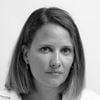Why are people in Colombia talking about this news anchor’s hairstyle?
Mábel Lara’s decision to leave her hair curly has been hailed as an act of resistance for the Afro-Colombian community


Mábel Lara is an Afro-Colombian journalist, who in February – after 15 years in television – decided to forget the straightening iron and host the weekend news on channel Noticias Uno with her naturally curly hair. “That day I lifted a load off my chest. I felt free,” she told Verne.
But this seemingly innocuous act caused a stir in Colombia. Lara began to receive hundreds of messages on social media and from media organizations asking her how a black woman was able to blow apart the country’s beauty stereotypes.
“The impact at the beginning scared me,” she says. “The public had only seen me with one look on television.” Before making the decision, she remembered how her previous attempts to appear with curly hair had failed. “They hounded me on social media with messages saying I was disheveled and ugly. During the Soccer World Cup they even called my hair vulgar and dirty.” To her it was a direct attack: “If our hair is dirty, we are dirty.”
After almost 15 years of being on television, finally I was able to appear with my naturally curly hair or afro. All my life I have battled with the stereotype of the woman with straight hair: I have exposed myself to hair irons and chemical treatments to "look better on screen." For women in general, hair is a symbol of power and those women who have afros, curls, who are black or mestizo have allowed ourselves to be told that our hair is bad, ugly, dirty and unmanageable. I want to have the freedom to look how I want to look, from my sense of femininity and thanks to the support of my director Cecilia Orozco today we have taken a step forward without judgment, freely, powerfully. Thank you for inspiring this change ... I don’t know if it will be forever but today I feel secure, strong and definitely me. Whether with curls, straight hair, afros, wigs or bald, blonde or redhead: owners of ourselves. Full stop. We continue with the news #Freedom #Withoutjudgement #Without stereotypes
The news anchor was criticized by both white and black people. Lara explains that Afro-Colombian women fight from when they are little “in order to belong.” “My mother gave me small black dolls so that I would feel like I belonged, but I felt ugly because I didn’t see anyone with curly hair on television.”
In a country where 20% of the population is black – most of whom live in poverty in the region bordering the Pacific Ocean (where Lara was born) – the best way for women to avoid discrimination is to have straight, light-colored hair and extensions. In other words, to make themselves look like white women. “Every black girl celebrates communion and her 15th birthday with straight hair,” says Lara. This is a photo of Lara in November last year.
A few years ago, a new generation of women began to rebel against this ideal of beauty. Young black women celebrated their curls, hair wraps and braids as a symbol of their culture. The first African people arrived in overcrowded boats to the Colombian port of Cartagena de Indias to be sold as slaves. The women drew maps with their hair braids to help others escape: patterns of rivers, mountains and roads indicated the route to safety.
“Black women have been battling for greater visibility”
“We have features that are part of our ethnicity. And hair is strength and power. For centuries we have fought for our hair. It is an issue of resistance,” says Lara. “We have become tired of looking like others when there are so many different forms of beauty.”
The journalist says she had to go through a transition period to be able to learn to recognize herself with her own hair. While Lara accepted, in her own words, her “unmanageable” curls, she says the process was much harder than she thought because her hair had been badly damaged by years’ of treatments and coloring.
“I remember a girl wrote to me when I posted a photo of my curls on Instagram. She was a fan in Chile. She told her bosses that she wanted to appear with her curly hair. The first thing she did was shave her head to make her hair healthy and then she let it grow out naturally. Cutting your hair is liberating,” says Lara.
According to the news presenter, the girl from Chile went to work with her new look but “had to resign from the company [air carrier] LAN Chile because they told her: these are the norms of beauty, either you fit in or you leave. So she left happy with her hair.”
It’s been months since Lara first appeared on national television with her curly hair. Her sister supports her decision but says for now she’d prefer not to risk herself by following Lara’s example and has stuck with the hair straightener. Meanwhile Lara’s mother – who spent lots of money on hair products for her daughters when they were little because, “for a black woman, hair is half the presentation” – says at least Lara’s curls are getting a break. And for Lara’s friends, the issue is whether this will be a passing fashion or the start of real change for Afro-Colombian women.
Lara is aware that she made her decision at a time where, thanks to her experience, she now has a name for herself: “I think it wouldn’t have been so easy at the beginning of my career. Now I have more freedom and I can freely show my blackness.” It may be a small move but it is part of a greater movement to defend the rights of Afro-Colombian women.
As Lara explains, “black women have been battling for greater visibility in Colombia to show that there are many of us in this country and we deserve to be treated like first-grade citizens. Every woman has fought from their own arena. We are achieving this.”
English version by Melissa Kitson.












































